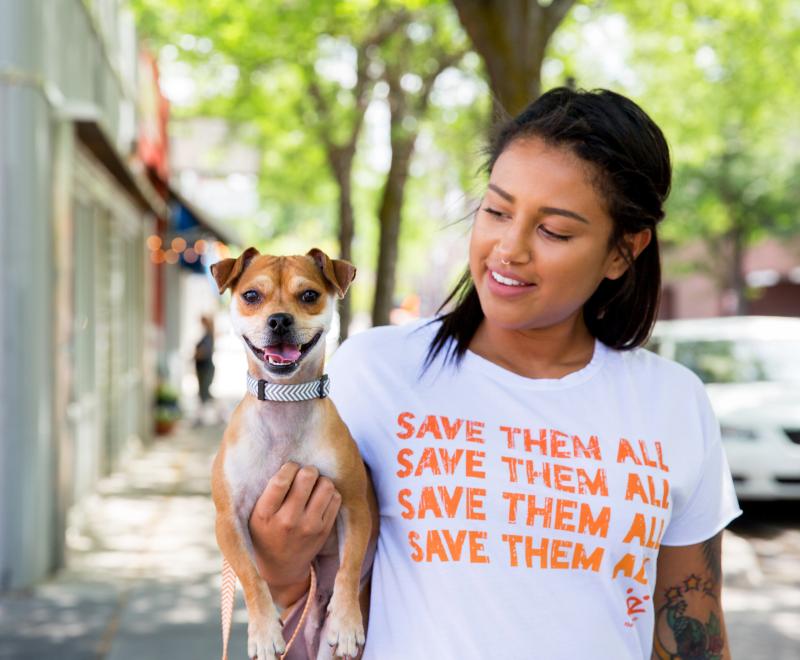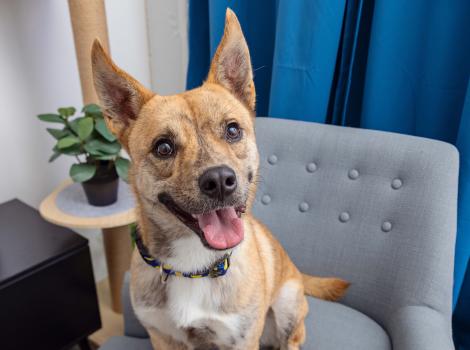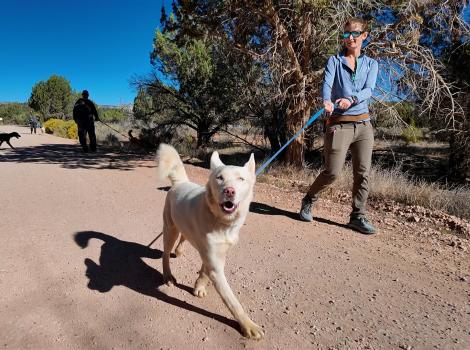40 fun facts about Best Friends Animal Society
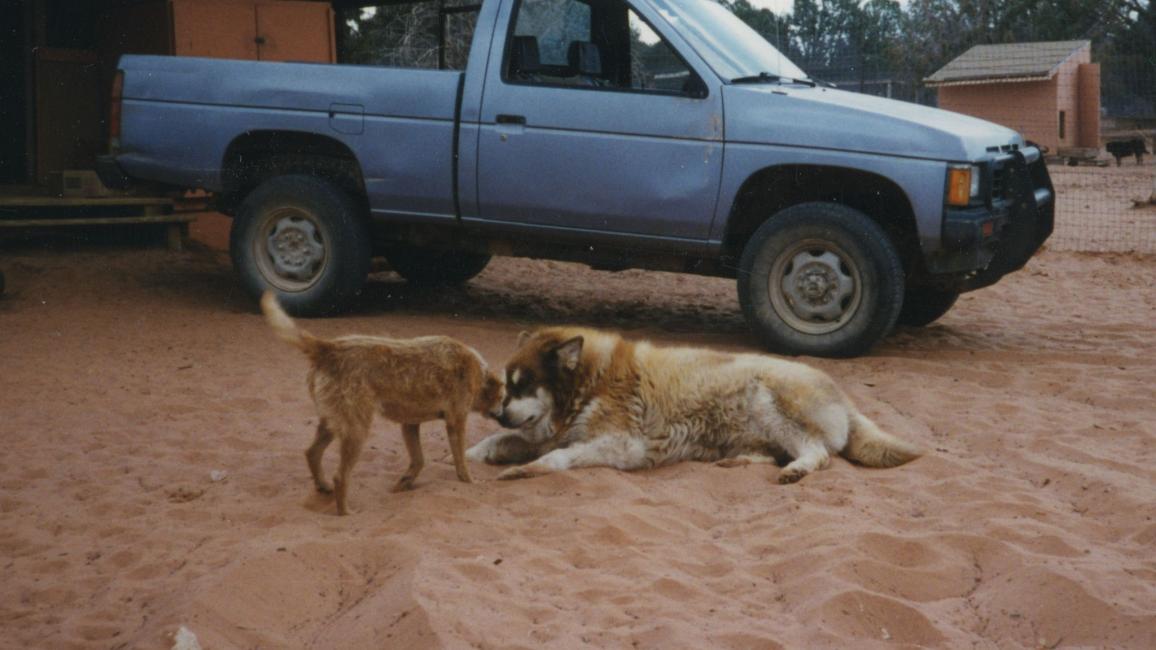
Lordy lordy, look who’s 40! This year marks four decades of Best Friends Animal Society saving animals’ lives. The years have been filled with lots of hard work, plenty of joy, and above all fierce love for all creatures. It all started in 1984 when a scrappy group of friends settled outside of a small town in Utah’s high desert to start a sanctuary, a home-between-homes for animals in need.
Since then countless dogs, cats, bunnies, birds, horses, pigs, wild animals, and other creatures have found safety at Best Friends Animal Sanctuary in Kanab, Utah. Today, Best Friends is working across the country to support shelters in saving pets’ lives right in the communities where they already live. It’s been quite a ride to go from a group of people with a dream to a national movement to stop killing dogs and cats in shelters.
You likely know that Best Friends’ goal is to make the entire country no-kill in 2025. But did you know that a cat at Best Friends once won a Pulitzer Prize? That’s just one gem out of these 40 fun facts and trivia fodder brought to you from Best Friends co-founders and colleagues in the know.
40 things you might not know about Best Friends
- Best Friends started with around 30 friends who had a dream. Today, there are hundreds of people working at the Sanctuary in Kanab, Utah, and across the United States. Several of the original founders are still active in Best Friends’ work.
- When the founders were originally constructing roads around the Sanctuary, they always built around trees to avoid having to cut them down — hence some of the winding roads that still exist today.
- Best Friends Animal Sanctuary was the organization’s only location until the first offsite adoption center opened in Los Angeles in 2011. Today there are five regional programs dedicated to pet adoptions, fostering, and more located in Los Angeles, Salt Lake City, Houston, Northwest Arkansas, and New York City.

- The original Sanctuary veterinary clinic was a donated airstream trailer with rotted floors, no windows, and shag carpeting. Local veterinarian Dr. Christie helped outfit the trailer, and soon he was up and running to provide medical care and spay/neuter to the animals. The trailer was christened the Silver Bullet, and all who worked on it could not have been prouder. Dr. Christie did a lot with very little, and in truth there would not be a Best Friends today if not for him.
- The Silver Bullet trailer was eventually replaced with a real building that was filled with equipment the founders salvaged from the demolition of a children’s hospital in Las Vegas. They were a scrappy bunch! That in turn was replaced in 2013 by the Best Friends Animal Clinic you’ll find at the Sanctuary today. It’s spacious, modern, and comfortable, and it offers the best care available to the pets it serves.
- What would one day become Best Friends magazine started as a bulletin board in the passageway between the kitchen and old laundry room at the Sanctuary’s Angel Village. It was called the Wall of Triumph, where co-founder Michael Mountain would post stories of good news about the animals — basically to cheer up other founders during those difficult early days.
- Today there are more than 4,800 Best Friends Network Partners across the country. These are public and private shelters, rescue groups, spay/neuter organizations, and other animal welfare organizations in all 50 states.

- Lots of different kinds of animals call the Sanctuary their home-between-homes, including dogs, cats, horses, parrots, rabbits, guinea pigs, potbellied pigs, donkeys, mules, goats, sheep, domestic birds, mink, reptiles, rodents, and Utah native wildlife.
- Years ago, three of the Best Friends co-founders became pilots to make travel easier. The first flight was to take a sheep to Salt Lake City for surgery.
- In the early days of Dogtown, there were more canine residents there than there are today — and with fewer staff and volunteers. Each dog caregiver would establish a group of dogs who would be let out of their runs to spend the day with them. The dogs would follow the caregivers throughout the day and then be put away in the evening. You could always tell where a staff person was by seeing “their” group of dogs waiting outside of a building.

- The “Disney barn,” still at the Sanctuary today, was a film set for the 1973 film One Little Indian, starring James Garner and 9-year-old Jodie Foster. Other TV shows and movies filmed in the canyon include The Lone Ranger, Lassie, Gunsmoke, The Outlaw Josie Wales, and dozens more.

- Volunteers make all Best Friends’ work possible. When the Sanctuary first started welcoming volunteer help, it began with a handful of people and grew from there. Today there are thousands of volunteers pitching in to help animals all across the country. They do everything including hands-on animal care, driving animals long hours to safety, emergency response, and at-home data entry.
- Tomato the cat, who had a regular column in Best Friends magazine for years, was awarded a Pulitzer Prize in August 2000. The award letter stated it was for a new category: “the Purr Prize for service to man’s best friends.”
- Dogtown wasn’t always known by that name. Back in the early days of the Sanctuary, it was sometimes referred to as “Dogland.” Either way, the dogs knew it was their special domain.
- In January 2008, 22 dogs from the Michael Vick dogfighting case came to Best Friends. We called them the Vicktory Dogs. All the Vicktory Dogs were either adopted or called the Sanctuary home for the rest of their lives.

- Best Friends Animal Sanctuary is in Kane County, Utah. The county is one of the largest in the state, at 4,109 square miles, and it has just two stoplights.
- Best Friends was one of the first animal organizations on the ground in New Orleans, pulling animals from the flood waters following Hurricane Katrina. We were the last animal organization to leave.

- The Sanctuary had almost no buildings or roads when Best Friends’ founders arrived. And while a couple of the founders did happen to be architects, none had ever physically built a building before. But a tight budget meant they had to learn. The book that famously guided them was the Reader’s Digest Complete Do-it-yourself Manual.
- The oldest animal currently living at the Sanctuary is an Amazon parrot named Paco, who hatched in 1957.

- Dogtown uses a unique design we call “octagons,” built for dogs to live in small groups of friends. Because of the buildings’ shape, a caregiver can stand at the center, observing all the groups of dogs at once in both their indoor rooms and outdoor yards.
- In her past, Best Friends co-founder Silva Battista worked in the gardens at Buckingham Palace.
- In 1987, Best Friends cat Queenie participated in what was believed to be the first successful cat kidney transplant at University of California, Davis. Queenie returned to the Sanctuary with Lily, her kitty kidney donor.
- Hay for the horses and other barnyard animals is stored in a cave at the Sanctuary. The previous property owner blew a 40-foot hole in the rock to create a naturally heated storage space for his RV. Using geothermal principles, the cave maintains 55 degrees Fahrenheit year-round when the outer doors are closed.

- Some of the more edgy spay/neuter campaigns in Best Friends’ past include Hooters for Neuters (in conjunction with the restaurant) and Desex and the City.
- Wild Friends is more than just one of the animal areas at the Sanctuary. It’s a state and federally licensed wildlife rehabilitation center.
- The Best Friends Roadhouse and Mercantile opened in Kanab in 2019. It’s a unique pet-centric hotel featuring built-in cubbies for pets to relax, a fenced-in pet park with a splash water feature, a self-service pet wash, and more. You can bring your own pets or take an animal from the Sanctuary for a sleepover.

- Best Friends has always made a lifetime commitment to every animal at the Sanctuary. If animals are adopted out and unforeseen circumstances prevent people from keeping the pet they adopted from Best Friends, we happily take them back.
- Back in the early ’90s, we hosted our first celebrity benefit at the famous Chateau Marmont with A-list guests. The event was eventually branded the Lint Roller Party with the taglines “Dare to Wear Black” and “Glitz, Glamour, Pet Hair.”
- Leaders at Best Friends aren’t afraid to look silly when it comes to saving lives. Holly Sizemore, Best Friends chief mission officer, once dressed up in a big orange Heathcliff cat costume and sat in a giant cat trap outside of Salt Lake County Animal Services to bring more attention to National Feral Cat Day and trap-neuter-vaccinate-return (TNVR).
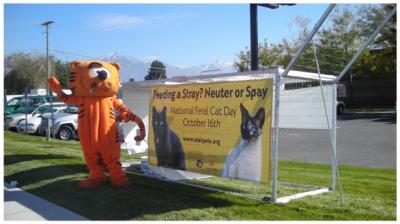
- Mollie will always be known as “the founding pig” at Best Friends. She lost her home because zoning laws prevented her from continuing to live with her family, and her story made national news. A local TV crew was even waiting for her when she arrived at the Sanctuary.
- Best Friends was the first organization to plan and host “super adoption” events designed to bring together hundreds of adoptable animals from multiple animal welfare organizations in one location to meet potential adopters.
- From the very beginning, Best Friends cared for bunnies. But it was nothing like what happened after one call came in. A woman explained that with two broken hips, she needed someone to rescue her rabbits. How many? 100, she said. But it turned out to be 170! With that one rescue, the Sanctuary’s Bunny House and the number of rabbits we cared for quickly grew.
- Angels Rest and Angels Overlook, the two areas at the Sanctuary where animals who have passed away are laid to rest, are filled with wind chimes placed in memory of much-loved pets. There’s also a labyrinth, paths in the red sand, benches in the shade, and other places to spend quiet time reflecting on the loss of loved ones.

- Ginger, a Chesapeake Bay retriever from a local backyard breeding operation, was one of the first residents of Dogtown. She was known for gathering up hundreds of yellow tennis balls and keeping them safe under a tree. The sea of yellow was known as Chesapeake Bay.
- One of the most popular spots at the Sanctuary is Angel Village Café, where staff, visitors, and volunteers gather every day. Why? Check out that view.

- For a time, when the Sanctuary was still originally under construction, Best Friends co-founder and current Chief Sanctuary Officer Judah Battista lived in a cattery with the cats.
- The oldest equine resident at Best Friends was Dee the Appaloosa, who lived to be 47 years old.
- Best Friends’ workshops on starting and running an animal sanctuary began back in 1998. Now, Best Friends offers a course in partnership with Southern Utah University called Running a Lifesaving Animal Sanctuary.
- The first Best Friends magazine was black and white, 24 pages, and printed on an old IBM copy machine. The first run was 50 copies.
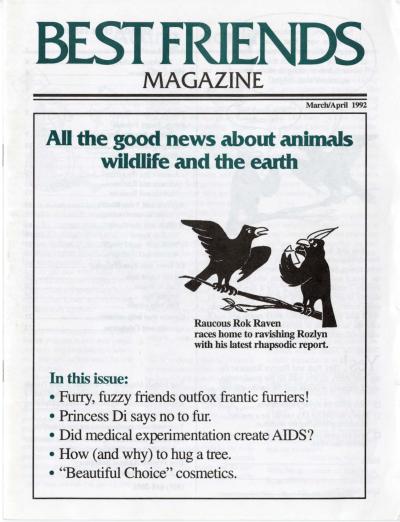
- Loving these fun facts about Best Friends? You can find more on the new special section of our website devoted to sharing historical videos, photos, and stories.
Let's make every shelter and every community no-kill in 2025
Our goal at Best Friends is to support all animal shelters in the U.S. in reaching no-kill in 2025. No-kill means saving every dog and cat in a shelter who can be saved, accounting for community safety and good quality of life for pets.
Shelter staff can’t do it alone. Saving animals in shelters is everyone’s responsibility, and it takes support and participation from the community. No-kill is possible when we work together thoughtfully, honestly, and collaboratively.



